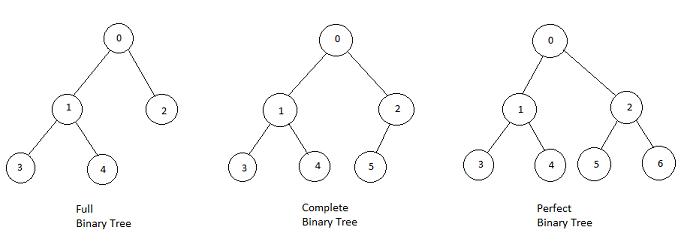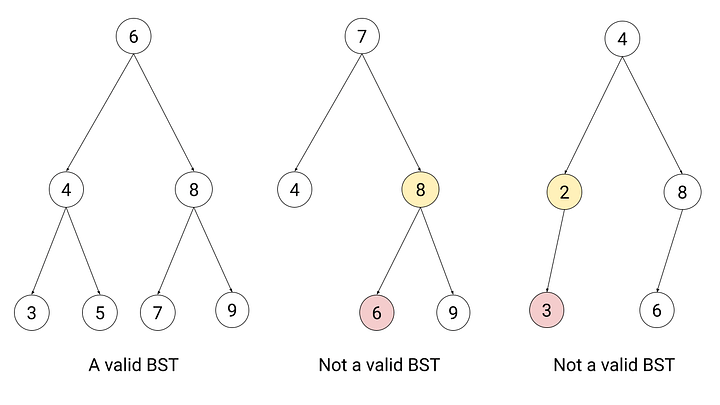⚫ Binary Tree in Tech Interviews 2024: Top 23 Questions & Answers
A Binary Tree is a hierarchical data structure in which each node has at most two children. Given their significance in computer science, they are commonly addressed in coding interviews to assess a candidate's understanding of data structures and related algorithms.
Check out our carefully selected list of basic and advanced Binary Tree questions and answers to be well-prepared for your tech interviews in 2024.
👉🏼 You can also find all answers here: Devinterview.io - Binary Tree
🔹 1. What is a Tree Data Structure?
Answer
A tree data structure is a hierarchical collection of nodes, typically visualized with a root at the top. Trees are typically used for representing relationships, hierarchies, and facilitating efficient data operations.
Core Definitions
- Node: The basic unit of a tree that contains data and may link to child nodes.
- Root: The tree's topmost node; no nodes point to the root.
- Parent / Child: Nodes with a direct connection; a parent points to its children.
- Leaf: A node that has no children.
- Edge: A link or reference from one node to another.
- Depth: The level of a node, or its distance from the root.
- Height: Maximum depth of any node in the tree.
Key Characteristics
- Hierarchical: Organized in parent-child relationships.
- Non-Sequential: Non-linear data storage ensures flexible and efficient access patterns.
- Directed: Nodes are connected unidirectionally.
- Acyclic: Trees do not have loops or cycles.
- Diverse Node Roles: Such as root and leaf.
Visual Representation
Common Tree Variants
- Binary Tree: Each node has a maximum of two children.
- Binary Search Tree (BST): A binary tree where each node's left subtree has values less than the node and the right subtree has values greater.
- AVL Tree: A BST that self-balances to optimize searches.
- B-Tree: Commonly used in databases to enable efficient access.
- Red-Black Tree: A BST that maintains balance using node coloring.
- Trie: Specifically designed for efficient string operations.
Practical Applications
- File Systems: Model directories and files.
- AI and Decision Making: Decision trees help in evaluating possible actions.
- Database Systems: Many databases use trees to index data efficiently.
Tree Traversals
Depth-First Search
- Preorder: Root, Left, Right.
- Inorder: Left, Root, Right (specific to binary trees).
- Postorder: Left, Right, Root.
Breadth-First Search
- Level Order: Traverse nodes by depth, moving from left to right.
Code Example: Binary Tree
Here is the Python code:
class Node:
def __init__(self, data):
self.left = None
self.right = None
self.data = data
# Create a tree structure
root = Node(1)
root.left, root.right = Node(2), Node(3)
root.left.left, root.right.right = Node(4), Node(5)
# Inorder traversal
def inorder_traversal(node):
if node:
inorder_traversal(node.left)
print(node.data, end=' ')
inorder_traversal(node.right)
# Expected Output: 4 2 1 3 5
print("Inorder Traversal: ")
inorder_traversal(root)🔹 2. What is a Binary Tree?
Answer
A Binary Tree is a hierarchical structure where each node has up to two children, termed as left child and right child. Each node holds a data element and pointers to its left and right children.
Binary Tree Types
- Full Binary Tree: Nodes either have two children or none.
- Complete Binary Tree: Every level, except possibly the last, is completely filled, with nodes skewed to the left.
- Perfect Binary Tree: All internal nodes have two children, and leaves exist on the same level.
Visual Representation
Applications
- Binary Search Trees: Efficient in lookup, addition, and removal operations.
- Expression Trees: Evaluate mathematical expressions.
- Heap: Backbone of priority queues.
- Trie: Optimized for string searches.
Code Example: Binary Tree & In-order Traversal
Here is the Python code:
class Node:
"""Binary tree node with left and right child."""
def __init__(self, data):
self.left = None
self.right = None
self.data = data
def insert(self, data):
"""Inserts a node into the tree."""
if data < self.data:
if self.left is None:
self.left = Node(data)
else:
self.left.insert(data)
elif data > self.data:
if self.right is None:
self.right = Node(data)
else:
self.right.insert(data)
def in_order_traversal(self):
"""Performs in-order traversal and returns a list of nodes."""
nodes = []
if self.left:
nodes += self.left.in_order_traversal()
nodes.append(self.data)
if self.right:
nodes += self.right.in_order_traversal()
return nodes
# Example usage:
# 1. Instantiate the root of the tree
root = Node(50)
# 2. Insert nodes (This will implicitly form a Binary Search Tree for simplicity)
values_to_insert = [30, 70, 20, 40, 60, 80]
for val in values_to_insert:
root.insert(val)
# 3. Perform in-order traversal
print(root.in_order_traversal()) # Expected Output: [20, 30, 40, 50, 60, 70, 80]🔹 3. What is Binary Heap?
Answer
A Binary Heap is a special binary tree that satisfies the Heap Property: parent nodes are ordered relative to their children.
There are two types of binary heaps:
- Min Heap: Parent nodes are less than or equal to their children.
- Max Heap: Parent nodes are greater than or equal to their children.
Key Characteristics
- Shape Property: A binary heap is a complete binary tree, which means all its levels are filled except the last one, which is filled from the left.
- Heap Property: Nodes follow a specific order—either min heap or max heap—relative to their children.
Visual Representation
Array-Based Representation
Due to the complete binary tree structure, binary heaps are often implemented as arrays, offering both spatial efficiency and cache-friendly access patterns.
- Root Element: Stored at index 0.
- Child-Parent Mapping:
- Left child:
(2*i) + 1 - Right child:
(2*i) + 2 - Parent:
(i-1) / 2
- Left child:
Example Array
Index: 0 1 2 3 4 5 6 7 8 9 10
Elements: 1 3 2 6 5 7 8 9 10 0 4
Advantages
- Memory Efficiency: No extra pointers needed.
- Cache Locality: Adjacent elements are stored closely, aiding cache efficiency.
Limitations
- Array Sizing: The array size must be predefined.
- Percolation: Insertions and deletions may require element swapping, adding computational overhead.
Code Example: Array-based Binary Heap Operations
Here is the Python code:
class BinaryHeap:
def __init__(self, array):
self.heap = array
def get_parent_index(self, index):
return (index - 1) // 2
def get_left_child_index(self, index):
return (2 * index) + 1
def get_right_child_index(self, index):
return (2 * index) + 2
# Example usage
heap = BinaryHeap([1, 3, 2, 6, 5, 7, 8, 9, 10, 0, 4])
parent_index = heap.get_parent_index(4)
left_child_index = heap.get_left_child_index(1)
print(f"Parent index of node at index 4: {parent_index}")
print(f"Left child index of node at index 1: {left_child_index}")🔹 4. What is a Binary Search Tree?
Answer
A Binary Search Tree (BST) is a binary tree optimized for quick lookup, insertion, and deletion operations. A BST has the distinct property that each node's left subtree contains values smaller than the node, and its right subtree contains values larger.
Key Characteristics
- Sorted Elements: Enables efficient searching and range queries.
- Recursive Definition: Each node and its subtrees also form a BST.
- Unique Elements: Generally, BSTs do not allow duplicates, although variations exist.
Visual Representation
Formal Properties
For any node
Practical Applications
- Databases: Used for efficient indexing.
- File Systems: Employed in OS for file indexing.
- Text Editors: Powers auto-completion and suggestions.
Time Complexity
-
Search:
$O(\log n)$ in balanced trees;$O(n)$ in skewed trees. -
Insertion: Averages
$O(\log n)$ ; worst case is$O(n)$ . -
Deletion: Averages
$O(\log n)$ ; worst case is$O(n)$ .
Code Example: Validating a BST
Here is the Python code:
def is_bst(node, min=float('-inf'), max=float('inf')):
if node is None:
return True
if not min < node.value < max:
return False
return (is_bst(node.left, min, node.value) and
is_bst(node.right, node.value, max))🔹 5. What are advantages and disadvantages of BST?
Answer
The Binary Search Tree (BST) is a versatile data structure that offers many benefits but also comes with limitations.
Advantages of Using BSTs
-
Quick Search Operations: A balanced BST can perform search operations in
$O(\log n)$ time, making it much faster than linear structures like arrays and linked lists. -
Dynamic Allocation: Unlike arrays that require pre-defined sizes, BSTs are dynamic in nature, adapting to data as it comes in. This results in better space utilization.
-
Space Efficiency: With
$O(n)$ space requirements, BSTs are often more memory-efficient than other structures like hash tables, especially in memory-sensitive applications. -
Versatile Operations: Beyond simple insertions and deletions, BSTs excel in:
- Range queries
- Nearest smaller or larger element searches
- Different types of tree traversals (in-order, pre-order, post-order)
-
Inherent Sorting: BSTs naturally keep their elements sorted, making them ideal for tasks that require efficient and frequent sorting.
-
Predictable Efficiency: Unlike hash tables, which can have unpredictable worst-case scenarios, a balanced BST maintains consistent
$O(\log n)$ performance. -
Practical Utility: BSTs find applications in:
- Database indexing for quick data retrieval
- Efficient file searching in operating systems
- Task scheduling based on priorities
Disadvantages of Using BSTs
-
Limited Direct Access: While operations like
insert,delete, andlookupare efficient, direct access to elements by index can be slow, taking$O(n)$ time in unbalanced trees. -
Risk of Imbalance: If not managed carefully, a BST can become unbalanced, resembling a linked list and losing its efficiency advantages.
-
Memory Costs: Each node in a BST requires additional memory for two child pointers, which could be a concern in memory-constrained environments.
-
Complex Self-Balancing Algorithms: While self-balancing trees like AVL or Red-Black trees mitigate the risk of imbalance, they are more complex to implement.
-
Lack of Global Optimum: BSTs do not readily provide access to the smallest or largest element, unlike data structures like heaps.
🔹 6. Explain the difference between Binary Tree and Binary Search Tree.
Answer
While Binary Trees and Binary Search Trees (BSTs) share a tree-like structure, they are differentiated by key features such as node ordering and operational efficiency.
Key Distinctions
Node Ordering
- Binary Tree: No specific ordering rules between parent and child nodes.
- BST: Nodes are ordered—left children are smaller, and right children are larger than the parent node.
Efficiency in Searching
-
Binary Tree:
$O(n)$ time complexity due to the need for full traversal in the worst case. -
BST: Improved efficiency with
$O(\log n)$ time complexity in balanced trees.
Node Insertion and Deletion
- Binary Tree: Flexible insertion without constraints.
- BST: Ordered insertion and deletion to maintain the tree's structure.
Tree Balancing
- Binary Tree: Generally, balancing is not required.
- BST: Balancing is crucial for optimized performance.
Use Cases
- Binary Tree: Often used in heaps, tries, and tree traversal algorithms.
- BST: Commonly used in dynamic data handling scenarios like maps or sets in standard libraries.
Visual Comparison
Binary Tree
In this Binary Tree, there's no specific ordering. For instance, 6 is greater than its parent node, 1, but is on the left subtree.
5
/ \
1 8
/ \
6 3
Binary Search Tree
Here, the Binary Search Tree maintains the ordering constraint. All nodes in the left subtree (3, 1) are less than 5, and all nodes in the right subtree (8) are greater than 5.
5
/ \
3 8
/ \
1 4
Key Takeaways
- BSTs offer enhanced efficiency in lookups and insertions.
- Binary Trees provide more flexibility but can be less efficient in searches.
- Both trees are comparable in terms of memory usage.
🔹 7. Compare Trie vs. Binary Search Trie.
Answer
While Tries are specialized for tasks involving strings and are especially efficient for datasets with shared prefixes, BSTs are versatile, general-purpose trees that can store any ordered data.
Time Complexity
Look-up
-
Trie: This is determined by the length of the word/key being looked up. Hence, the time complexity is
$O(m)$ , where$m$ is the length of the key. -
BST: Efficient look-ups in balanced BSTs are
$O(\log n)$ , but if the BST becomes skewed, it degrades to$O(n)$ .
Insertion and Deletion
-
Trie: Insertion and deletion are typically
$O(m)$ , with$m$ being the key's length. -
BST: Insertion and deletion are
$O(\log n)$ in a balanced tree. However, in the worst-case scenario (unbalanced tree), these operations can take$O(n)$ time.
Space Complexity
- Trie: Often more space-efficient, especially when dealing with datasets having short keys with common prefixes. It can save considerable space by sharing common prefix nodes.
- BST: Every node in the BST requires storage for its key and pointers to its two children. This fixed overhead can make BSTs less space-efficient than tries, especially for large datasets.
Specialized Operations
- Trie: Excels at operations like longest-prefix matching, making it an ideal choice for applications such as autocompletion, IP routing, and more.
- BST: While not specialized like tries, BSTs are more general-purpose and can handle a wider range of tasks.
Maintenance and Balance
- Trie: Inherently balanced, making them relatively low-maintenance. This ensures consistent performance without the need for additional balancing algorithms.
- BST: To maintain efficient operation, BSTs often require balancing using specific algorithms or tree structures like AVL or Red-Black trees. Without periodic balancing, the tree could become skewed, leading to suboptimal performance.
🔹 8. What is a Balanced Tree?
Answer
👉🏼 Check out all 23 answers here: Devinterview.io - Binary Tree
🔹 9. What is a Red-Black Tree?
Answer
👉🏼 Check out all 23 answers here: Devinterview.io - Binary Tree
🔹 10. How does Inserting or Deleting nodes affect a Red-Black Tree?
Answer
👉🏼 Check out all 23 answers here: Devinterview.io - Binary Tree
🔹 11. What is the time complexity for Insert into Red-Black Tree?
Answer
👉🏼 Check out all 23 answers here: Devinterview.io - Binary Tree
🔹 12. What is the difference between Heap and Red-Black Tree?
Answer
👉🏼 Check out all 23 answers here: Devinterview.io - Binary Tree
🔹 13. What is AVL Tree? How to Balance it?
Answer
👉🏼 Check out all 23 answers here: Devinterview.io - Binary Tree
🔹 14. When standard BSTs might be preferred over AVL Trees?
Answer
👉🏼 Check out all 23 answers here: Devinterview.io - Binary Tree
🔹 15. Compare Red-Black Trees and AVL Trees.
Answer
👉🏼 Check out all 23 answers here: Devinterview.io - Binary Tree
🔹 16. How is an AVL Tree different from a B-Tree?
Answer
👉🏼 Check out all 23 answers here: Devinterview.io - Binary Tree
🔹 17. Name some ways to implement Priority Queue.
Answer
👉🏼 Check out all 23 answers here: Devinterview.io - Binary Tree
🔹 18. Classify Tree Traversal Algorithms.
Answer
👉🏼 Check out all 23 answers here: Devinterview.io - Binary Tree
🔹 19. What is Morris Traversal for a Tree? How to implement one?
Answer
👉🏼 Check out all 23 answers here: Devinterview.io - Binary Tree
🔹 20. Implement Pre-order Traversal of Binary Tree using Recursion.
Answer
👉🏼 Check out all 23 answers here: Devinterview.io - Binary Tree
🔹 21. Implement Iterative Pre-order Traversal of a Binary Tree without Recursion.
Answer
👉🏼 Check out all 23 answers here: Devinterview.io - Binary Tree
🔹 22. Convert a Binary Tree into a Doubly Linked List.
Answer
👉🏼 Check out all 23 answers here: Devinterview.io - Binary Tree
🔹 23. Build a Binary Expression Tree for the given expression.
Answer
👉🏼 Check out all 23 answers here: Devinterview.io - Binary Tree

.png?alt=media&token=d6b820e4-e956-4e5b-8190-2f8a38acc6af&_gl=1*3qk9u9*_ga*OTYzMjY5NTkwLjE2ODg4NDM4Njg.*_ga_CW55HF8NVT*MTY5NzI4NzY1Ny4xNTUuMS4xNjk3Mjg5NDU1LjUzLjAuMA..)

.png?alt=media&token=3c2136ee-ada1-41c9-9ddb-590e4338f585)
